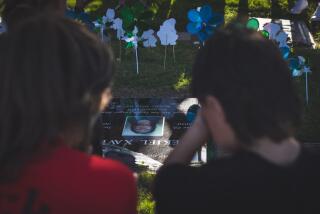Death Not Linked to Stimulant
- Share via
In their final report on the death of a 15-year-old Fillmore athlete, coroners have concluded she was the victim not of an herbal supplement, but of a rare and previously undetected heart condition.
The report issued Thursday represents a reversal of the initial suspicions of the Santa Barbara County coroner’s office. After an autopsy, that office had tentatively linked the death of Rosanna Porras to Ripped Fuel, an over-the-counter stimulant she reportedly had taken to boost her sports performance.
Rosanna collapsed at a soccer practice in April. She was taken to Santa Paula Memorial Hospital for emergency treatment and died three days later at Santa Barbara Cottage Hospital, where she had been transferred.
Her death drew nationwide attention because of the possibility that it was caused by one of the dozens of commercial herbal supplements popular with athletes, bodybuilders and dieters. However, that possibility was virtually eliminated by a team from the office of the chief medical examiner in Boston, which Santa Barbara coroners consulted following Rosanna’s autopsy.
Examining the girl’s heart, the Boston coroners found evidence of Bland-Garland-White syndrome, a congenital defect that affects one in 5,000 babies and often results in death within a year. Few undiagnosed victims of the syndrome make it into their late teens, according to medical experts.
The Santa Barbara coroner’s final report could draw no conclusion on Ripped Fuel because it had not been identified with certainty in Rosanna’s body.
*
“There is no evidence that Ripped Fuel played any role in this tragic occurrence,” Ross Blechman, president of Twinlab, the company that make the supplement, said in a statement Thursday. “Our sympathies go to her family and loved ones.”
Blood samples drawn at Santa Paula Memorial Hospital contained none of Ripped Fuel’s key ingredients, according to the report.
Doctors who pumped Rosanna’s stomach had seen partially digested pills that looked similar to the Ripped Fuel pills brought in by Rosanna’s father, Henry Porras. However, hospital employees did not save the stomach contents for later examination, said Larry Gillespie, a deputy coroner in Santa Barbara.
Even so, Ripped Fuel was a suspect early on. It contains a form of ephedrine, a stimulant found in many over-the-counter cold pills but one that also has triggered hundreds of complaints to the Food and Drug Administration. One of Rosanna’s friends told her family she and other school athletes had been using the energy booster.
At Rosanna’s autopsy, Santa Barbara coroners discovered massive heart damage that she had suffered as long as 10 days before her death.
At the time, Gillespie suggested Ripped Fuel may have been the cause.
“There is essentially no other explanation, or good explanation, for a massive heart attack of this severity in a 15-year-old other than something like this product or the drug in this product,” he said during an interview.
*
At the suggestion of the FDA, Gillespie’s office conferred with their counterparts in Boston, who in 1996 had linked the fatal heart attack of a 23-year-old man to Ripped Fuel.
But the Boston doctors made no such determination in Rosanna’s case.
Instead, they found Rosanna’s left coronary artery located in the wrong place--the key characteristic of Bland-Garland-White syndrome.
The anomaly was not detected in the Santa Barbara autopsy because coroners there, knowing they would consult outside experts, did not cut into Rosanna’s heart, Gillespie said.
The incision would have been necessary to see the problem, he added.
The left coronary artery ordinarily supplies much of the heart muscle with oxygenated blood. However, Rosanna’s was attached not at the base of the aorta--its usual place--but at the pulmonary artery. Consequently, blood feeding her heart was oxygen-poor--a condition that eventually kills children with the syndrome.
The finding perplexed Rosanna’s family.
“Whether my daughter could have lived a lot longer, who knows?” asked Henry Porras. “We don’t know the severity of this condition. And it’s not in our family history at all--my parents, my wife’s parents died in their 80s.”
*
And whatever the combination of factors that may have killed Rosanna, some things don’t change, Porras said: “The pain, my feelings are still the same.”
Paradoxically, Rosanna, a track star and the president of her freshman class, may have been a victim of her own vitality. In some cases, children complain of chest pains, shortness of breath and palpitations. But Rosanna never showed any symptoms and always was active, family members said.
Children who are not in such good shape are sometimes diagnosed after erratic electrocardiograms or chest X-rays showing enlarged hearts, said Dr. Makato Takahashi, a pediatric cardiologist at Childrens Hospital in Los Angeles and a professor at the USC School of Medicine.
“If the child is healthy enough and doesn’t get a physical examination, they may miss it,” he said.
In older children, the syndrome can be corrected with a “relatively easy surgery,” he added.
Whether Ripped Fuel may have aggravated her condition will never be known. That possibility was suggested in the Santa Barbara coroner’s report, which also acknowledged that “investigators cannot say with certainty” the supplement contributed to her death.
Someone with Bland-Garland-White syndrome would be more susceptible than most people to heart problems stemming from ephedrine and caffeine, said Dr. Michele Hamilton, an associate clinical professor of cardiology at UCLA. However, she added, rigorous exercise “could be as much a stimulant to the heart as any herbal supplement.”
More to Read
Sign up for Essential California
The most important California stories and recommendations in your inbox every morning.
You may occasionally receive promotional content from the Los Angeles Times.














